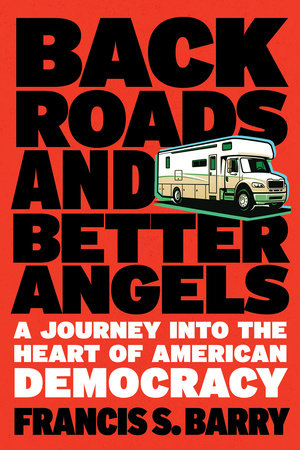Back Roads and Better Angels: A Journey into the Heart of American Democracy
- By Francis S. Barry
- Steerforth Press
- 560 pp.
- Reviewed by Larry Matthews
- July 25, 2024
Finding solace and surprises along the Lincoln Highway.

I’m a sucker for “travel across America” books. John Steinbeck’s Travels with Charley or William Least Heat-Moon’s Blue Highways come to mind. The kind of book where the author drives the nation’s backroads to find “real Americans” who are colorful and offer homegrown bromides, hard cider, and maybe directions to the world’s largest donut. With that in mind, I plowed into Francis S. Barry’s Back Roads and Better Angels, a doorstopper-sized trip from one coast to the other and back.
Barry, a journalist at Bloomberg, talked his bosses into letting him take off for months with his wife, Laurel, in a 25-foot Winnebago Navion “with a full bed, toilet, shower, sink, stove, oven, dinette table, and even two televisions.” The couple named it “Charley” after Steinbeck’s poodle companion in Travels with Charley. Neither had ever driven a camper. They didn’t even own a car. They live in New York City.
The plan was to follow the Lincoln Highway from Times Square, where it begins, to San Francisco, where it ends. The highway came about in the early part of the 20th century, when there were few decent roads outside of cities. There were celebrations and speeches when the project — named for the country’s beloved 16th president — was launched. By the time it concluded, the “highway” was no more than a hodgepodge collection of dirt lanes, a few paved thoroughfares, and lots of good intentions.
For some reason, Barry finds it necessary to tell us that Back Roads and Better Angels is not “another book about Trump.” But there will be politics, because it’s inescapable, especially during the covid lockdown of September 2020, which is when the couple sets off. Barry then proceeds to mine the highway’s Lincoln connection for so many stories about racism and other despicable episodes that, for a time, I wondered if the book would be a travelogue of awful things. To wit: He launches his voyage on Wall Street:
“Where the wall once stood, enslaved Africans staged a revolt in 1712 that killed nine white residents. In the days that followed, seventy Africans were arrested and twenty were executed, three burned at the stake…We will see battles over rights and liberties, and walls, all along the journey.”
And we do. The country’s shameful racial history is displayed in many locations along the Lincoln Highway. Mercifully, we’re also treated to happier moments. Outside of Gettysburg, Pennsylvania, for instance, we’re introduced to Mister Ed’s Elephant Museum and Candy Emporium, where a sign reads, “We believe in chocolate for breakfast.” Inside are 12,000 pachyderm-themed items and 700 varieties of sweets.
The journey — made more challenging by the couple’s complete lack of experience with a large RV and its inevitable mechanical and plumbing issues — is peppered with Barry’s frequent history lessons. In many of them, the weight of that history — including the terrible cruelty inflicted on African Americans and Native Americans — feels especially heavy. Add to that the ongoing tension and depression surrounding the pandemic. Access to some sites is restricted, people aren’t working, and masking is a volatile social issue. Here and there, Barry and Laurel, who wear masks, encounter people who defiantly do not.
There are poignant moments, too, such as when they cross the Mississippi River. Writes Barry:
“Ascending the bridge over the Mississippi River, a sense of awe washes over me — awe that we have made it to this east-west dividing line and at the history that has flowed beneath us. No river has carried more of the nation’s cultural, political, and economic freight. Slavery and civil war, the agricultural and industrial revolutions, Indian wars and westward expansion — the river ran deep through them all.”
An unexpected bright spot is Cedar Rapids, Iowa, which has embraced multiculturalism. Here, in the state’s second-largest city, Muslims helped build a Christian Orthodox church, and its members, in turn, helped build a mosque. It’s also where the couple encounters “Iowa nice.” “We come to a four-way stop with three other vehicles,” Barry recalls. “Everyone waits. No one honks. We’ve heard of Iowa nice but this is hard to believe.”
I once asked a bestselling author how he knew what to leave in and what to take out of his books. He replied, “I take out the stuff readers skip over.” At 560 pages, there’s a lot to skip over here. Barry wanders off into material that might’ve best been left out, slowing the story and tempting the reader to jump ahead.
Finally, while it’s easy to view Back Roads and Better Angels as a book about America today, it’s really more about America’s past as explored by two city dwellers during the pandemic. In other words, it’s no Travels with Charley or Blue Highways, but it does offer a glimpse of who we were in 2020, if not who we are in 2024.
Larry Matthews is the author of Age in Good Time and other books.
_1_80_127.png)
